
GIS In Agriculture: Best Practices For AgriTech Leaders
The power to readily collect and analyze farmland data is one of many reasons why geographic information systems (GIS) are so valuable in agriculture. Field machinery on the ground and drones and satellites in the sky collect GIS agriculture data. Then, this information can be used for a wide variety of purposes, from precision farming and crop prediction to livestock tracking. Major agrifood stakeholders routinely utilize GIS solutions for agriculture to boost short-term profits and realize long-term goals of sustainable development.
What Is GIS In Agriculture?
GIS is a tool that lets users create multi-layered interactive maps that can be used for the visualization of complex data and for spatial analysis. How is GIS related to agriculture? The use of GIS in agriculture enables farmers to map field data, organize and analyze it, and monitor their crops remotely.
GPS, robotics, drone and satellite monitoring have all contributed to farm automation. These technologies underpin collecting GIS data. By visualizing data, GIS helps farmers spot trends and patterns, implement change detection, and quickly address issues. Precision agriculture relies heavily on GIS to collect and interpret massive field data for informed decision-making.
With the use of GIS, farmers may maximize their land’s potential in terms of yield increase and financial savings, not to mention reduced environmental effects.
The scope of modern agriculture has expanded beyond domestic farmlands to encompass the entire planet. For agriculture corporations, maintaining a productive crop calls for regular remote field observation and prompt problem-solving. This is why GIS solutions with constant multi-factor danger assessments are so crucial in today’s agriculture.
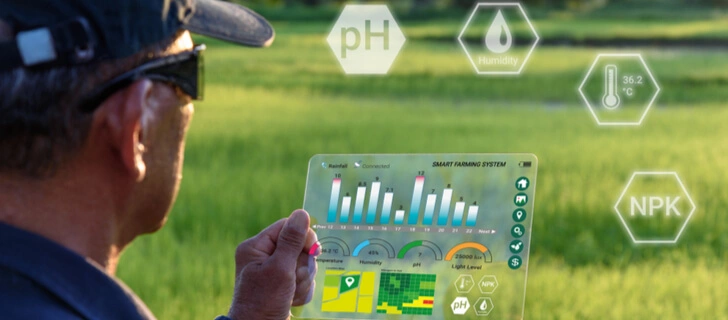
Agricultural GIS Data: Where It Comes From And How It’s Processed
Hardware, software, and information all come together in GIS technology. Any device, from a simple laptop or desktop computer to something more complex like a satellite or a drone, can serve as the hardware. GIS software utilizes maps to display spatial data. Images are created using a variety of GIS technologies and then linked to relevant maps and data that is hidden from view. What you end up with is a map not only showing the location and overall health of your crops but also taking into account other relevant factors such as terrain, soil type, and fertilization. It’s time we tracked down where all that agriculture GIS data comes from and how it is processed.
Remote Sensing
Remote sensing involves aerial or satellite scans of the Earth’s surface. When it comes to medium spatial resolution land remote sensing data gathered from space, Landsat data is unrivaled. The Landsat 8 is an observation satellite that orbits Earth every 16 days. It records nine visible light bands helping assess crop health, nutrient content, insect infestation, or moisture. Not only does Landsat 8 record visible light, but also invisible to the human eye thermal infrared radiation (TIR) .
Agriculture GIS tools visualize the collected data as digital images to better serve broad goals, such as precision irrigation or plant disease identification. In addition to Landsat 8, private companies are increasingly launching their GIS agriculture satellites for niche applications, like monitoring fields, water supplies, temperature fluctuations, and more.
GPS
GPS and GIS integration lets farmers collect real-time data, including position. In other words, agriculture producers may boost resource utilization efficiency by employing gadgets to precisely plot where to use these resources on a given farm. GPS-enabled field mapping helps analyze crop varieties, elevation levels, field boundaries, irrigation systems, etc.
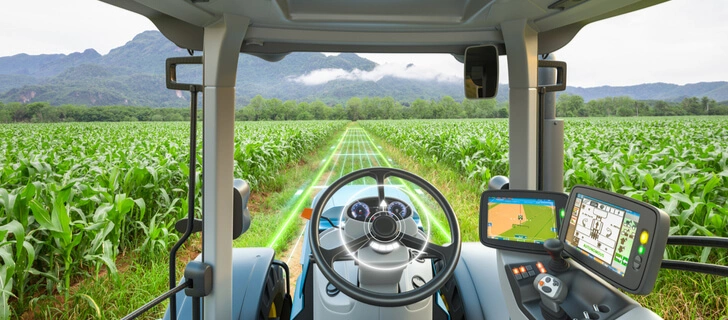
Machinery
GIS agriculture machinery sensors add “ground data” to “data from the sky” obtained by satellites. GPS tracking equipment in sowing machines, smart irrigation systems, and harvesters allows farmers to measure crop production and quality (e.g., moisture or chlorophyll levels) in real time and at a specific location. Some advanced agriculture machines may act autonomously based on the data they collect, while others are used to supplement GIS analysis.
EOSDA Crop Monitoring
Using satellite monitoring for remote fields management in one platform!
EOSDA Crop Monitoring As An Example Of Agriculture GIS Software
It should be noted that GIS software in agriculture might vary depending on its purpose. Some tools indicate crop types, yields, and distributions. Some visualize soil moisture levels to help users decide what to plant. Some other software helps to compare the economic costs and benefits of forestry vs. logging. Therefore, it is the responsibility of each farmer or agriculture manager to find a GIS solution that provides data for them to make informed farmland decisions.
When it comes to field data, the EOSDA Crop Monitoring digital agriculture platform has you covered in many ways. Historical vegetation and weather data, a summary of the dynamics of the vegetation indices and the soil moisture index, and accurate 14-day weather forecasts are available here. In addition to providing access to GIS-based agriculture data, the platform includes capabilities such as:
- scouting, which improves task management and allows scouts to create and send reports to owners in real time;
- field activity log for planning, coordinating, and monitoring all field operations.
Having all of these options in one place boosts agricultural businesses and organizations that engage with them.
EOSDA Crop Monitoring also combines data from other sources. For instance, the Data Manager tool in EOSDA Crop Monitoring integrates machinery data into the platform. The system is compatible with SHP and ISO-XML, the two most common file types. A data set may include more than one metric. Based on data from field machines, you can assess the crop’s yield, compare it to fertilizer maps, draw conclusions about the effectiveness of the fertilizer strategy, and develop yield-boosting strategies.
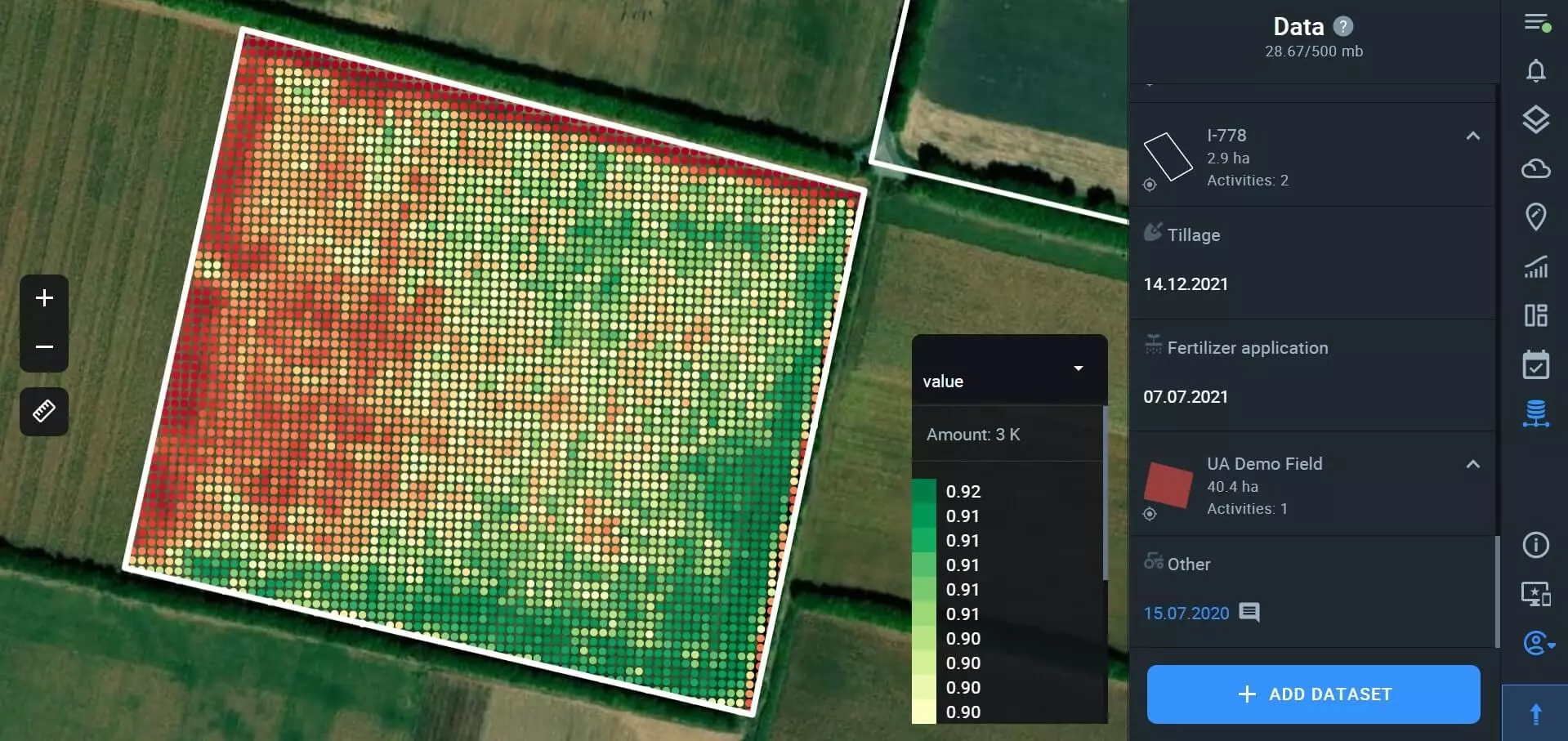
GIS technology is essential for modern farming businesses. It’s time to figure out how to leverage GIS-based software, particularly EOSDA Crop Monitoring, in agricultural settings.
How Is GIS Used In Agriculture?
The number of GIS applications in agriculture has exploded in recent years thanks to technological advancements. Let’s discuss some of the most popular current applications.
Precision Agriculture
Precision agriculture GIS software provides detailed vegetation and productivity maps, including crop information, for making reasonable decisions. Agriculture GIS tools can identify vegetation levels in your field or any of its areas. Agriculture machinery can then use this information to adjust seed, nutrients, herbicides, and fertilizer amounts for each plot.
EOSDA Crop Monitoring lets you create productivity maps of your fields using data from previous years. With their guidance, you can identify productive and unproductive areas and fertilize the unproductive ones with potassium-phosphorus solutions.
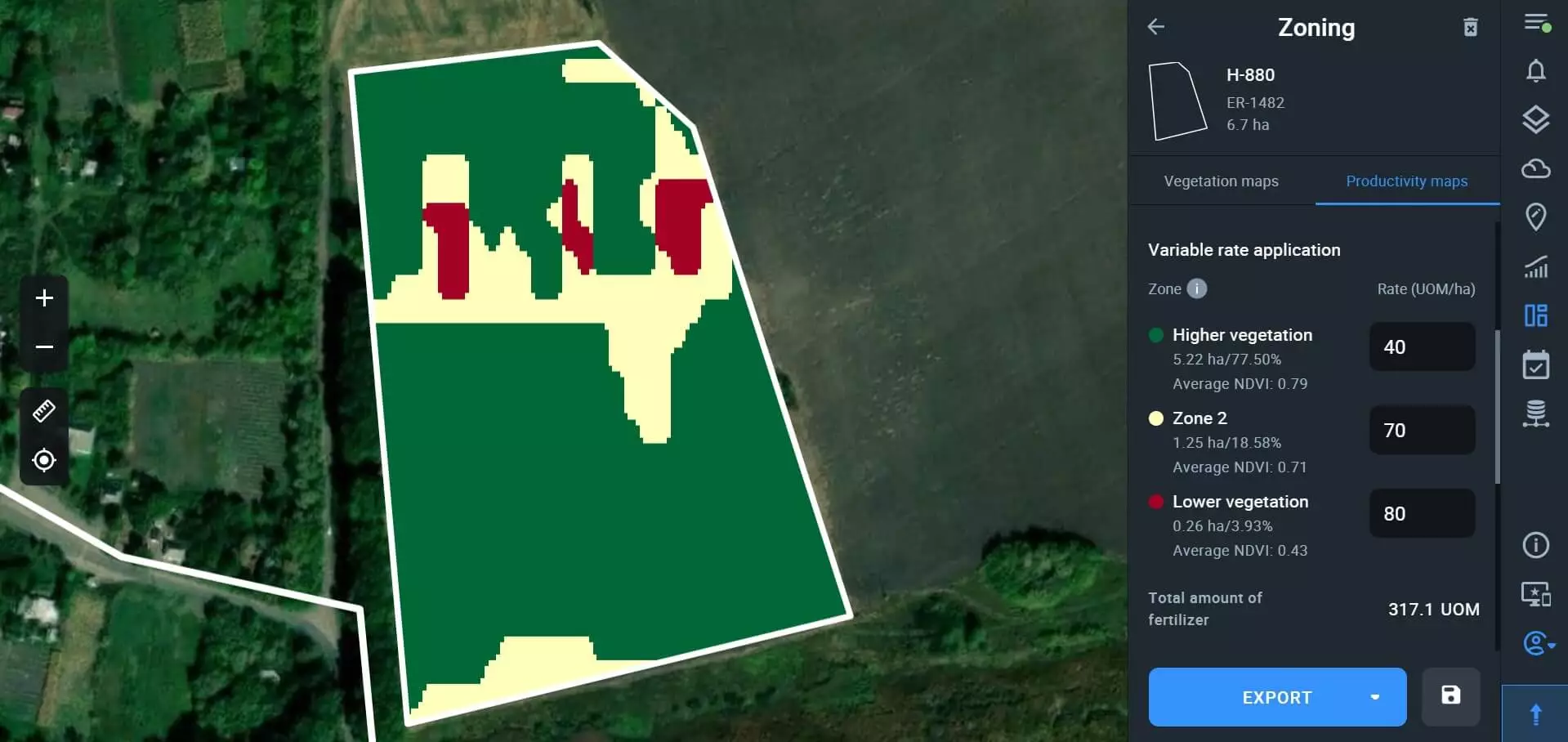
Agriculture Mapping
Soil and crop analysis can be facilitated by satellite sensors, allowing the creation of soil index maps and maps of vegetation indices such as the Normalized Difference Vegetation Index (NDVI). Agriculture GIS mapping aids field monitoring and management for successful crop production.
Comparing field vegetation on several dates or using various indices might help you determine how different variables affect yield. EOSDA Crop Monitoring now includes a Split View feature, allowing you to view the current state of your field alongside historical data from the past week, month, or year, or check the performance of two different indices on the same date.
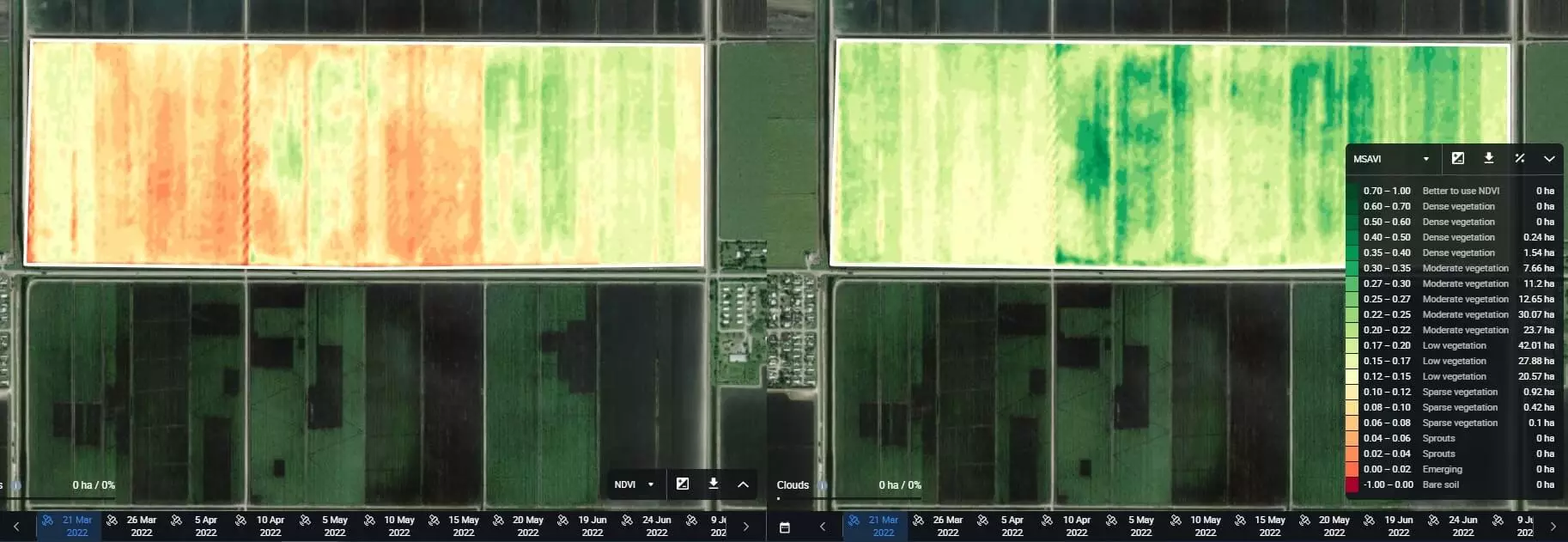
In the given case, the NDVI alone suggests that certain fields may need reseeding since not all seeds germinated. The MSAVI index, however, designed specifically to track seedlings, reveals even vegetation throughout the field.
Crop Health Monitoring
Manually checking crops across a large area is the slowest and most labor-intensive method of monitoring crop health. Remote sensing and GIS in agriculture are lifesavers for this.
GIS-based precision agriculture can help you prioritize which crops need extra care. Imagery sensors on satellites and aircraft provide an advanced method for monitoring crop temperatures. An abnormally high temperature could indicate disease, pest infestation, or dehydration.
Livestock Monitoring
Agriculture GIS software is essential for tracking animals’ movements in animal husbandry. GIS agriculture tools help farmers locate livestock on a farm and monitor their health, growth, fertility, and nutrition. Animal trackers and a portable device that can receive and display tracker data enable this application.
Insect And Pest Control
Scouting large fields for pest infestations is wasteful. Deep learning algorithms and satellite data can assist in finding unhealthy spots.
EOSDA Crop Monitoring aids in detecting various risks, from weeds to crop diseases, by using field-collected vegetation indices. If the index map indicates low vegetation in a small area, meaning the possible presence of a parasite or disease there, a scout no longer has to investigate a large field. After identifying the probable infection zone using the vegetation index, you can use the Scouting feature to narrow your target area. Scouts can inspect the selected area and rapidly send photos of accomplished tasks and threat types using the EOSDA Crop Monitoring mobile app.
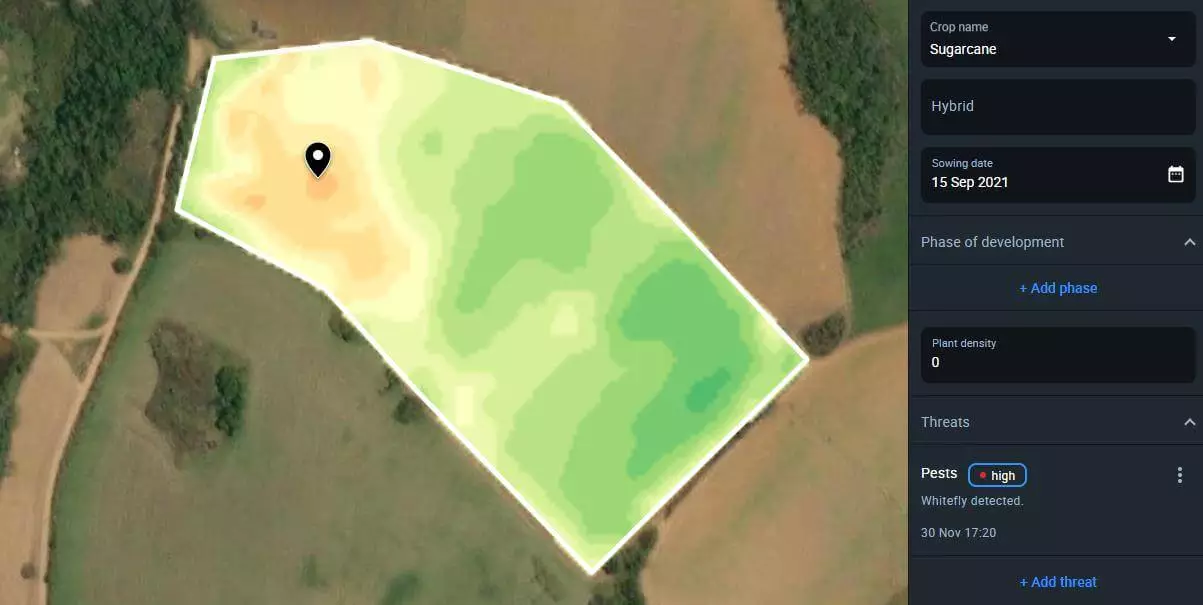
Irrigation Control
Dry spells, as well as extreme precipitation in low-lying areas without adequate drainage, can ruin crop output. Through agriculture GIS technology, farmers may assess the degree of water stress experienced by each crop and recognize visual patterns that suggest an oversupply or deficiency of water, which can be used to regulate irrigation.
Water stress is typically detected using the NDWI or NDMI indices. The NDMI index, available in EOSDA Crop Monitoring by default, ranges from -1 to 1, providing an intuitive interpretation of the data collected. Negative numbers around -1 indicate water shortages, whereas positive ones near 1 could indicate waterlogging.
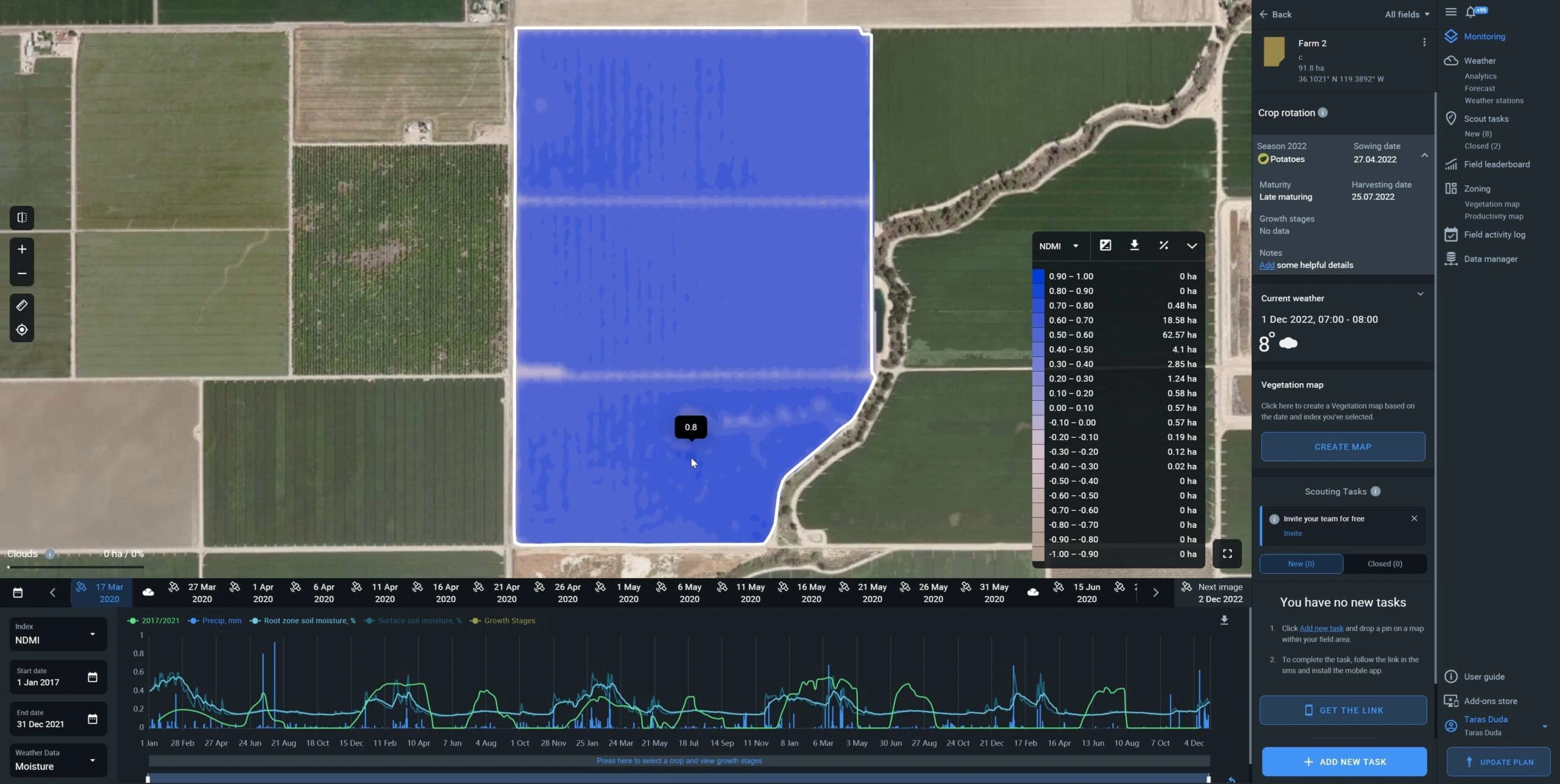
Nutrient Distribution
Farmers can only decide whether or not to fertilize the soil after knowing what nutrients are already present in a specific field. By analyzing the field’s nutrient status and detecting nutrient deficiency with GIS, agriculture producers can deliver nutrients from the outside more precisely.
Crop Yield Prediction
Governments and enterprises need reliable yield estimates to secure food supplies and predict profits and budgets. These forecasts are now possible thanks to technological advances that have linked satellites, remote sensing, big data, and artificial intelligence. EOSDA has developed a reliable approach for crop yield prediction with an accuracy of over 90% based on historical and current crop data derived from satellites.
Agriculture is one of many spheres where GIS technologies can be applied. Geographic information systems are widely used in many areas, including environmental protection, deforestation and reforestation management, urban planning, disaster mitigation, and more.
How Agriculture Majors Use GIS
All the major participants in the agriculture industry use GIS. The benefits that GIS-powered solutions can bring to each domain deserve careful consideration.
Insurance Companies
GIS data facilitates the insurance companies’ analysis of the insured regions, allowing for collecting a sufficient pool of indicators from which to form payments and terms. In the future, these companies will use the same GIS agriculture tools to monitor crop development and assess yield losses.
Banks
By gaining a deeper comprehension of the local community’s needs, GIS allows banks to expand into new agriculture markets and increase their ROI. When deciding whether or not to lend money to farmers, banks and other financial institutions can employ GIS tools to evaluate the projects’ viability and risks.
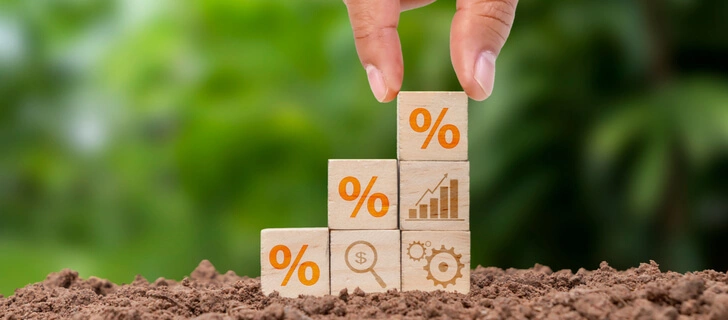
Input Suppliers
GIS-based agriculture solutions are helpful for input suppliers, allowing them to see how their product performs in the field. They can assess the impact of fertilizers and other additives on crop yields by comparing the results before and after the treatment.
IT And Telecom Companies
GIS allows IT and telecom companies to improve their offerings, reach wider audiences, and create infrastructure in previously inaccessible locations. With the help of GIS-based solutions, IT and telecom firms may also improve their market standings while bringing precision agriculture closer to their customers.
Agricultural Agencies
Compliance with laws governing pesticide and food safety , policy economic consequences, environmental health issues, land use conflict resolution, and data collecting and recording are all examples of using GIS by agricultural agencies.
Governments And NGOs
Governments and NGOs often use GIS in the field of environmental protection. Their experts analyze climate change, greenhouse gas emissions from deforestation agriculture and industrial production, and other public concerns.
Agricultural Consultants
Agri advisors may find the most significant benefit from agriculture GIS software because they can now study historical data and monitor their clients’ crops regardless of location. Agriculture consultants can make well-informed recommendations for field management and track their effectiveness using different types of data and vegetation indices.
The adoption of GIS by major agriculture stakeholders is an essential investment in sustainable and efficient farmland management.

Application Of GIS In Sustainable Agriculture
With the growing population, ensuring that there will always be enough food for everybody is critical. With the help of GIS technology, governments, activists, scientists, and agriculture producers may study and develop methods to ensure food supply and, by extension, the survival of the human species. For instance, the Food and Agriculture Organization (FAO) has been using GIS and other geospatial technologies to establish sustainable food systems worldwide for over 30 years.
You can apply GIS for sustainable agriculture in many ways, including switching to organic farming, pinpointing the most productive and environmentally friendly locations for planting new crops, and allocating farmland to keep food production going in the future. Organizations working on sustainable development use GIS to:
- monitor water supplies and forecast droughts;
- estimate and predict yields;
- evaluate the economic and environmental effects of human activities and natural phenomena;
- combine and analyze agriculture data from several sources;
- share data and maps between departments and organizations;
- serve as an online information and guidance resource for local communities.
By incorporating a spatial dimension into sustainable agricultural practices and policies, GIS technology helps the farming industry remain viable for future generations. The ability to guarantee agriculture sustainability will only increase as technology develops.
About the author:
Kateryna Sergieieva has a Ph.D. in information technologies and 15 years of experience in remote sensing. She is a Senior Scientist at EOSDA responsible for developing technologies for satellite monitoring and surface feature change detection. Kateryna is an author of over 60 scientific publications.
Recent articles

Analyze 2025 & Plan Your Best Year Yet: LandViewer Christmas Offer
It’s the most wonderful time of the year! The Christmas holidays are here, and so is your chance to analyze 2025 and plan a prosperous 2026 with more affordable Pro plans in LandViewer.

EOSDA Models Climate Change Impact On Sugarcane Yields
EOSDA modeled future temperature, rainfall, and other climate impacts on Veracruz sugarcane. The results help growers plan long-term adaptation strategies, including timing, varieties, and irrigation.

EOSDA LandViewer Black Friday Sale: Exclusive Offers & Giveaway
This Black Friday, LandViewer offers new users the chance to save on monthly plans, get extra months with yearly subscriptions, and participate in a free annual plan giveaway.